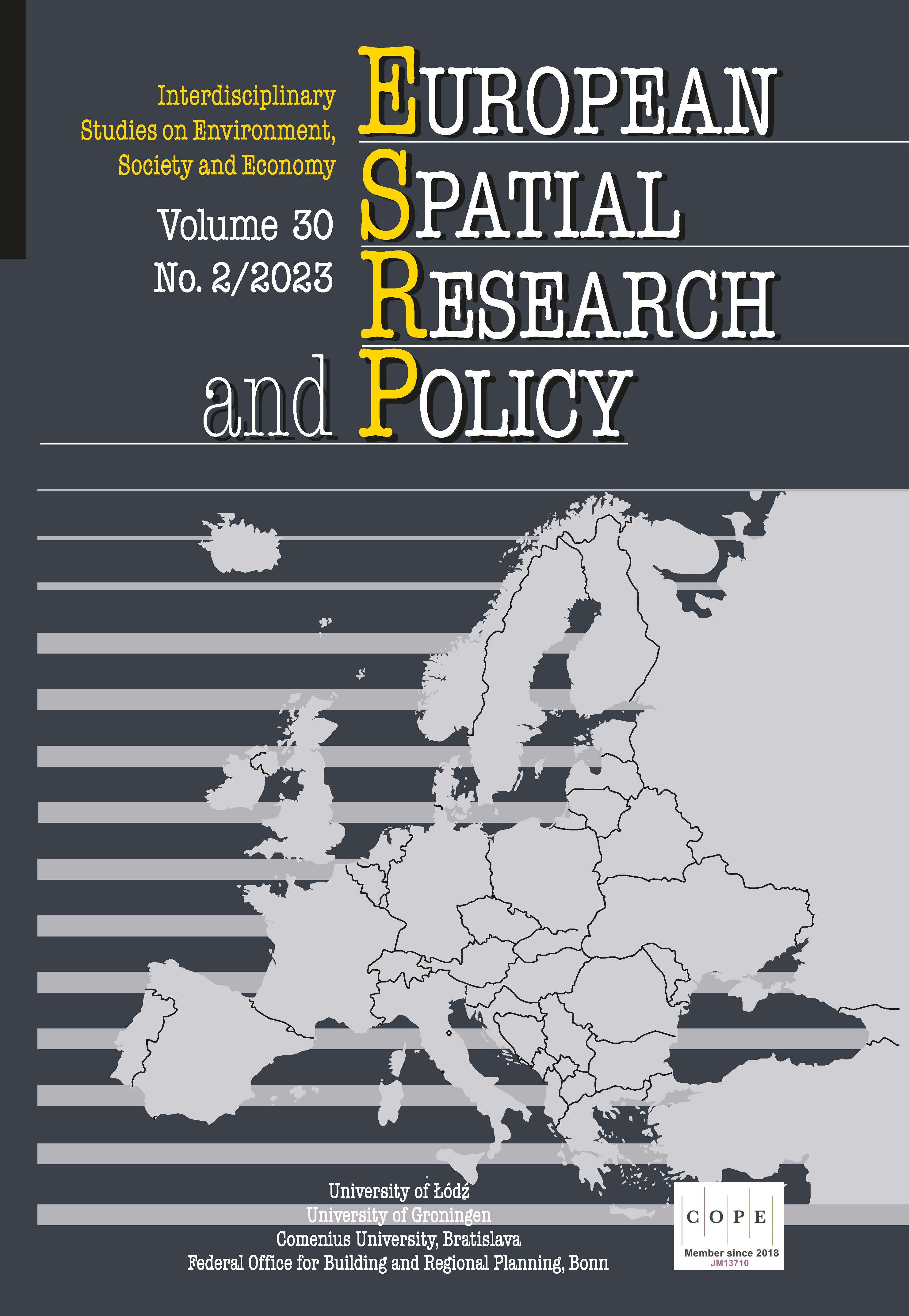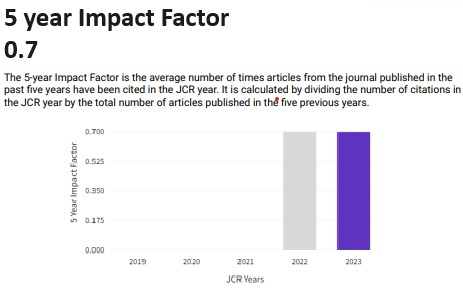Identifying exurbs: A multi-criteria approach for Germany
DOI:
https://doi.org/10.18778/1231-1952.30.2.06Keywords:
Exurb, Urban development, Regional development, Residential location, CommutingAbstract
The debate about exurbanites and exurbs has ever been an Anglo-American phenomenon. Due to the limitless space for growth and the individual preferences of living in single-family homes, the exurban census tracts were the fastest growing urban type in the USA for several decades. The increase in highway infrastructure lead to an auto-centric development of land and an ongoing urban sprawl in search for natural amenities and affordable housing. This was not the case in Europe for a long time as Europeans preferred to live closer to the place of work and the historically grown structures of the urban development. However, after the COVID-19 pandemic and the restructuring of a new office culture with remote work as the new condition and growing preferences for more living space and green amenities, exurbs could also evolve in the European context. In this investigation, the authors try to identify exurbs in the German context based on a multi-criteria analysis. We find that they are mostly located in the east and north of Germany around Hamburg and Berlin, and to a minor extent to the west and south of Germany. While there has not been a significant increase of exurbs in the past years, the question remains whether the COVID-19 pandemic has influenced the exurbanisation and the related issues to a sustainable urban development according to SDG 11. Further research on the characteristics of exurbs is needed to provide additional policy recommendations and monitor the development of potential exurbs in the future.
Downloads
References
AMMANN, I. and MÜTHER, A. M. (2022), ‘Wohneigentumsbildung und Wohnflächenverbrauch – Bestandsaufnahme und zukünftige Entwicklung’, BBSR Analysen Kompakt, 14.
Google Scholar
ANTROP, M. (2000), ‘Changing patterns in the urbanized countryside of Western Europe’, Landscape Ecology, 15, pp. 257–270.
Google Scholar
AUDIRAC, I., SHERMYEN, A. H. and SMITH, M. T. (1990), ‘Ideal urban form and visions of the good life Florida’s growth management dilemma’, Journal of the American Planning Association, 56 (4), pp. 470−482.
Google Scholar
VAN DEN BERG, L., KLAASSEN, L. H., DREWETT, R., ROSSI, A. and VIJVERBERT, C. H. (1982), Urban Europe: A study of growth and decline, Pergamon.
Google Scholar
BERGEAUD, A., EYMEOUD, J. B., GARCIA, T. and HENRICOT, D. (2023), ‘Working from home and corporate real estate’, Regional Science and Urban Economics, 103878.
Google Scholar
BERUBE, A., SINGER, A., WILSON, J. H. and FREY, W. F. (2006), ‘Finding Exurbia: America’s Fast-Growing Communities at the Metropolitan Fringe’, The Brookings Institution, Living Cities Census Series.
Google Scholar
BROMBACH, K., JESSEN, J., SIEDENTOP, S. and ZAKRZEWSKI, P. (2017), ‘Demographic Patterns of Reurbanisation and Housing in Metropolitan Regions in the US and Germany, Comparative Population Studies’, Zeitschrift für Bevölkerungswissenschaft, 42, pp. 281–318.
Google Scholar
CARRUTHERS, J. and VIAS, A. C. (2005), ‘Urban, suburban, and exurban sprawl in the rocky mountain west: Evidence from regional adjustment models’, Journal of Regional Science, 45 (1), pp. 21–48. http://dx.doi.org/10.1111/j.0022-4146.2005.00363.x
Google Scholar
CARUSO, G., PEETERS, D., CAVAILHÈS, J. and ROUNSEVELL, M. (2007), ‘Spatial configurations in a periurban city. A cellular automata-based microeconomic model’, [in:] Regional Science and Urban Economics 37, pp. 542–567.
Google Scholar
CHARMES, E. (2009), ‘On the Residential ‘Clubbisation’ of French Periurban Municipalities’, Urban Studies, 46 (1), pp.189–212.
Google Scholar
CLARK, J., MCCHESNEY, R., MUNROE, D. and IRWIN, E. (2009), ‘Spatial characteristics of exurban settlement pattern in the US’, Landscape and Urban Planning, 90 (3–4), pp. 178–188. DOI: 10.1016/j.landurbplan.2008.11.002
Google Scholar
CRUMP, J. R. (2016), Exurbia, The Blackwell Encyclopedia of Sociology. https://doi.org/10.1002/9781405165518.wbeose092.pub2
Google Scholar
CRUMP, J. R. (2003), ‘Finding a place in the country: Exurban and suburban development in Sonoma County, California’, Environment and Behavior, 35 (2), pp. 187–202.
Google Scholar
COURT, N. and BORAK, D. (2023), Remote Work is costing Manhattan more than 12 billion $ a year, https://www.bloomberg.com/graphics/2023-manhattan-work-from-home/?utm_content=citylab&utm_campaign=socialflow-organic&utm_source=twitter&utm_medium=social,15/02/2023 [accessed on: 08.09.2023].
Google Scholar
DANIELZYK, R., DITTRICH-WESBUER, A., HILTI, N. and TIPPEL, C. (2020), ‘Multilokale Lebensführungen und räumliche Entwicklung - ein Kompendium, Hannover’, Forschungsberichte der ARL, 13.
Google Scholar
DAVIS, J., NELSON, A. and DUEKER, K. (1994), ‘The new burbs: The exurbs and their implications for planning policy’, Journal of the American Planning Association, 60 (1), pp. 45–59.
Google Scholar
DAVIS, J. (1993), ‘The commuting of exurban home buyers’, Urban Geography, 14 (1), pp. 7–29. https://doi.org/10.2747/0272-3638.14.1.7
Google Scholar
DEMBSKI, S, SYKES, O., COUCH, C., DESJARDINS, X, EVERS, D., OSTERHAGE, F., SIEDENTOP, S. and ZIMMERMANN, K. (2019), ‘Reurbanisation and suburbia in Northwest Europe: A comparative perspective on spatial trends and policy approaches’, [in:] Progress in Planning, 150, https://doi.org/10.1016/j.progress.2019.100462
Google Scholar
EGAN, A. F. and LULOFF, A. E. (2000), ‘The exurbanization of America’s forests: Research in social science’, Journal of Forestry, 98 (3), pp. 26–30. DOI: 10.1080/01944369408975551
Google Scholar
EUROSTAT (2018), Territorial typologies manual - cities, commuting zones and functional urban areas, https://ec.europa.eu/eurostat/statistics-explained/index.php?title=Territorial_typologies_manual_-_cities,_commuting_zones_and_functional_urban_areas#Changes_to_the_typology_over_time. 08/02/23 [accessed on: 08.09.2023].
Google Scholar
FLORIDA, R., and OZIMEK, A. (2021), ‘How Remote Work Is Reshaping America’s Urban Geography’, Wall Street Journal, https://www.wsj.com/articles/how-remote-work-is-reshaping-americas-urban-geography-11614960100, 25/04/2021 [accessed on: 05.03.2021].
Google Scholar
GANS, H. J. (1962), The urban villagers: group and class in the life of Italian-Americans, New York: Free Press, 1962, 367 p.
Google Scholar
GODDARD, J., (2009), ‘Landscape and ambience on the urban fringe: from agricultural to imagined countryside’, Environmental History, 15, pp. 413–439.
Google Scholar
GOLDING, S. A. and WINKLER, R. L. (2020), ‘Tracking urbanization and exurbs: migration across the rural–urban continuum, 1990–2016’, Population research and policy review, 39, pp. 835−859.
Google Scholar
GROWE, A., HEIDER, K., LAMKER, Ch., PAßLICK, S. and TERFRÜCHTE, T. (2012) (eds), ‘Polyzentrale Stadtregionen – Die Region als planerischer Handlungsraum 14. Junges Forum der ARL 22. bis 24. Juni 2011 in Dortmund’, Arbeitsberichte der ARL 3, Hannover.
Google Scholar
HANSEN, A., KNIGHT, R., MARZLUFF, J., BROWN, S. P. K., GUDE, P. H., and KINGSFORD J. (2005), ‘Effects of Exurban Development on Biodiversity: Patterns, Mechanisms, and Research Needs’, Ecological Applications, 15 (6), pp. 1893–1905.
Google Scholar
HAYDEN, D. (2003), Building Suburbia, Pantheon/New York.
Google Scholar
HESSE, M. and SIEDENTOP, S. (2018), ‘Suburbanisation and Suburbanisms – Making Sense of Continental European Developments’, [in:] Raumforschung und Raumordnung | Spatial Research and Planning, 76 (2), pp. 97–108. doi: 10.1007/s13147-018-0526-3.
Google Scholar
KABISCH, N. and HAASE, D. (2011), ‘Diversifying European agglomerations: evidence of urban population trends for the 21st century’, Population, space and place, 17 (3), pp. 236–253.
Google Scholar
KEIL, R. (2018), ‘Suburban Planet’ Making the World Urban from Outside in, Cambridge.
Google Scholar
KEIL, R. and ADDIE, J. P. (2016), ‘«It’s not going to be suburban, it’s going to be all urban» Assembling Post-Suburbia in the Toronto and Chicago Regions’, International Journal of Urban and Regional Research, 39 (5), pp. 892–911.
Google Scholar
KEIL, R. and SHIELDS, R. (2013), ‘Suburban Boundaries, beyond greenbelts and edges’, [in:] KEIL, R. (ed.), Suburban Constellations. Governance, land and infrasstructure in the 21sr century, Berlin, pp. 71–78.
Google Scholar
LAMB, R. (1983), ‘The Extent and Form of Exurban Sprawl’, Growth and Change, 14 (1), pp. 40–47.
Google Scholar
LANG, R. and SANCHEZ, T. (2006), ‘The new metro politics: Interpreting recent presidential elections using a county-based regional typology’, Metropolitan Institute.
Google Scholar
LARSEN, S. C., SORENSON, S., MCDERMOTT, D., LONG, J. and POST, C. (2007), ‘Place Perception and Social Interaction on an Exurban Landscape in Central Colorado’, [in:] The Professional Geographer, 59 (4), pp. 421–433.
Google Scholar
Laufende Raumbeobachtung des BBSR (2022), Inkar database, www.inkar.de [accessed on 27.11.2023].
Google Scholar
LINK, T. (2021), ‘Empirische Definition von Stadt’, Informationen zur Raumentwicklung, 48 (1), pp. 12–19.
Google Scholar
LUCY, W. H. and PHILLIPS, D. L. (1997), ‘The post-suburban era comes to Richmond: city decline, suburban transition, and exurban growth’, [in:] Landscape and Urban Planning, 36, pp. 259–275.
Google Scholar
NASSAUER, J. I., COOPER, D. A., MARSHALL, L. L., CURRIE, W. S., HUTCHINS, M. and BROWN, D. G. (2014), ‘Parcel size related to household behaviors affecting carbon storage in exurban residential landscapes’, Landscape and Urban Planning, 129, pp. 55–64.
Google Scholar
NELSON, A. C. (1992), ‘Characterizing exurbia’, Journal of Planning Literature, 6 (4), pp. 350–368. doi.org/10.1177/088541229200600402
Google Scholar
NELSON, A. C. and SANCHEZ, T. W. (1999), ‘Debunking the exurban myth: A comparison of suburban households’, Housing Policy Debate, 10 (3), pp. 689–709.
Google Scholar
NELSON, A. C. and DUEKER, K. J. (1990), ‘The exurbanization of America and its planning policy implications’, Impact of Learning City Networks on Multi-Level Urban Development and Transformation Processes, 9 (2), pp. 91–100. doi.org/10.1177/0739456X9000900201
Google Scholar
NEUMANN, U., SPELLERBERG, A. and EICHHOLZ, L. (2022), ‘Veränderungen beim Wohnen und von Standortpräferenzen durch Homeoffice in der COVID-19-Pandemie?’, Raumforschung und Raumordnung|Spatial Research and Planning, 80 (4), pp. 434–450.
Google Scholar
OLAYODE, I. O., SEVERINO, A. G., CAMPISI, T. and TARTIBU, L. K. (2022), ‘Comprehensive literature review on the impacts of COVID-19 pandemic on public road transportation system: challenges and solutions’, Sustainability, 14 (15), 9586.
Google Scholar
OSGOOD, J. L. (2011), ‘Exurban Dynamics: An Analysis of Migration and Urban Containment Policies’, Urbana: Urban Affairs and Public Policy, 11, pp. 1–27.
Google Scholar
PHELPS, N. (2015), Sequel to Suburbia Glimpses of America’s Post-Suburban Future, Cambride/MA.
Google Scholar
PHELPS, N. (2017a), ‘Old Europe, New Suburbanization’, Govenance, Land, and Infrastructure in European Suburbanisation.
Google Scholar
PHELPS, N. (2017b), Interplaces. An Economic Geography of the Inter-urban and International Economie, Oxford.
Google Scholar
PIORR, A., RAVETZ, J. and TOSICS, I. (2011), Peri-urbanisation in Europe: Towards a European Policy to Sustain Urban-Rural Futures, A Synthesis Report.
Google Scholar
ROBINSON, L., NEWELL, J. P. and MARZLUFF, J. M. (2005), ‘A Twenty-five years of sprawl in the Seattle region: growth management responses and implications for conservation’, Landscape and Urban Planning, 71, pp. 51–72.
Google Scholar
RÜGER, H., GREINKE, L. and SKORA, T. (2022), ‘Reduziert erwerbsbedingte Multilokalität das zivilgesellschaftliche Engagement? Ergebnisse für Deutschland anhand von quantitativen und qualitativen Daten’, Raumforschung und Raumordnung|Spatial Research and Planning, 80 (4), pp. 479–496.
Google Scholar
SCAFF, A. H. (1952), ‘The Effect of Commuting on Participation in Voluntary Associations’, American Sociological Review, 17, pp. 215–230.
Google Scholar
SCHMITZ-VELTIN, A. (2015), ‘Reurbanisierung im Kontext einer neuen Unübersichtlichkeit regionaler Entwicklungsmuster, das Beispiel der Stadtregion Stuttart’, [in:] FRICKE, A., SIEDENTOP, S. and ZAKRZEWSKI P. (eds) Akademie für Raumforschung und Landesplanung , Reurbanisierung in Baden-Württembergischen Stadtregionen, ARL-Arbeitsbericht 14, Hannover, pp. 77–96.
Google Scholar
SHRESTHA, M., YORK, A. M., BOONE, C. G. and ZHANG, S. (2012), ‘Land fragmentation due to rapid urbanization in the Phoenix Metropolitan Area: Analyzing the spatiotemporal patterns and drivers’, Applied Geography, 32 (2012), pp. 522–531.
Google Scholar
SMITH, M. and SHARP, J. (2005), ‘Growth, development, and farming in an Ohio exurban region’, Environment and Behavior, 37 (4), pp. 565–79.
Google Scholar
SPECTORSKY, A. C. (1958), The Exurbanites, Lippincott.
Google Scholar
TAYLOR, L. (2011), ‘No boundaries: exurbia and the study of contemporary urban dispersion’, Geo-Journal, 76, pp. 323–339. DOI 10.1007/s10708-009-9300-y
Google Scholar
THEOBALD, D. M. (2005), ‘Landscape patterns of exurban growth in the USA from 1980 to 2020’, Ecology and Society, 10 (1), p. 32.
Google Scholar
UN (2023), Department of Economic and Social Affairs Sustainable Development, https://sdgs.un-.org/ [accessed on: 08.09.2023].
Google Scholar
VISSCHER, R. S., NASSAUER, J. I., BROWN, D. G., CURRIE, W. S., and PARKER, D. C. (2014), ‘Exurban residential household behaviors and values: Influence of parcel size and neighbors on carbon storage potential’, Landscape and Urban Planning, 132, pp. 37–46. http://dx.doi.org/10.1007/s12132-011-9123-z
Google Scholar
WOLMAN, H., GALSTER, G., HANSON, R., RATCLIFFE, M., FURDELL, K., and SARZYNSKI, A. (2005), ‘The fundamental challenge in measuring sprawl: which land should be considered?’, The Professional Geographer, 57 (1), pp. 94−105.
Google Scholar
WU, F. and KEIL, R. (2020), ‘Changing the geographies of sub/urban theory: Asian perspectives’, Urban Geography, pp. 1−7. https://doi.org/10.1080/02723638.2020.1712115
Google Scholar
WU, F., ZHANG, F. and WEBSTER, C. (2013), ‘Informality and the development and demolition of urban villages in the Chinese peri-urban area’, Urban studies, 50 (10), pp. 1919–1934.
Google Scholar
WU, F. and PHELPS, N. A. (2011), ‘(Post) suburban development and state entrepreneurialism in Beijing’s outer suburbs’, Environment and Planning A, 43 (2), pp. 410–430.
Google Scholar
Published
Versions
- 2024-02-07 (2)
- 2023-12-30 (1)
How to Cite
Issue
Section
License

This work is licensed under a Creative Commons Attribution-NonCommercial-NoDerivatives 4.0 International License.














